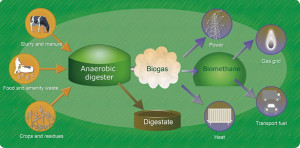Bioenergy can be derived from biomass when micro-organisms feed on it or when it reacts with biochemicals. There are various traditional as well as new methods to do this. Here we will discuss a few of the common processes.
Anaerobic Digestion (AD)
In anaerobic digestion, biomass is put in an airtight vessel, where micro-organisms grow in it in the absence of oxygen. This produces digestates and biogas. Digestates are used in farms as fertilizers and soil conditioners. Biogas consists of 70% methane and 30% carbon dioxide. Biogas is combusted to generate heat and electricity, or burned as a fuel in a boiler or furnace. Further processing and upgrading of biogas leads to removal of the carbon dioxide content. The leftover methane is known as Biomethane or Renewable Natural Gas. Biomethane is almost identical to natural gas and considered to be the cleanest and most environmental friendly vehicle fuel.

Image Courtesy: www.leogroupuk.net
Ethanol Fermentation
Fermentation, as we know, is the process used for brewing wine and beer. It involves the conversion of sugar rich biomass plants (sugarcane, corn) into alcohol through the addition of bacteria, yeasts and enzymes. The same process is further extended to include distillation to obtain Ethanol (ethyl alcohol). Ethanol is used as a green substitute for gasoline or as a fuel enhancer. Research suggests that Biobutanol, a derivative of ethanol, has the ability to completely eliminate the use of gasoline in petrol engines.
Methane Production in Landfills
Every city or town has its own landfill(s) where all the garbage of the locality is dumped. Inside these landfills, bacteria naturally decomposes and consumes the organic matter in the mounds of dumped waste and releases gases that are rich in methane content (around 50%). This methane from the landfills can be properly channeled to generate electricity, fire boilers, and transferred through pipelines to renewable natural gas plants. Otherwise, if emitted in the atmosphere, methane can cause serious environmental damage. With the ongoing urbanization and industrialization around the world, methane from landfills can serve as a viable source of bioenergy and result in effective waste management as well.
Transesterification
The biochemical process that converts plant and animal oils into biodiesel is called Transesterification. During this process, vegetable oils and animal fats are forced to react with a catalyst (sodium hydroxide and methanol or ethanol), resulting in the production of glycerol and fatty acid esters. These fatty acid esters are what we call biodiesel. Biodiesel can be sourced from plants like soybeans, rapeseed, palm, corn, sunflower and animal fats like tallow, poultry fats and fish oils and even used cooking oils from restaurants. Recent developments have resulted in the generation of biodiesel from algae and bacteria stains. Biodiesel is widely produced and consumed in the European Union as a substitute for petrol and diesel.
Biomass: Inexhaustible Source of Energy
5 Common Biofuels to Know About
Thermal and Thermochemical Conversion of Biomass into Energy



